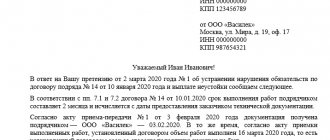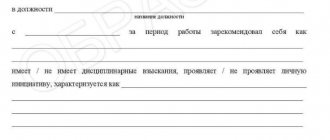When a batch of goods is delivered, there is a possibility that the goods will be defective. It is important for the customer to competently and correctly file a claim for defective goods.
Filing a claim seems like a simple procedure. However, it has many nuances that should be taken into account when drawing up the document. To protect the rights and interests of the customer, the indication of mandatory information plays an important role. A correctly drafted claim will help avoid or simplify litigation.
How to correctly write a response to a complaint - sample, basic rules for drafting
The rules for drawing up responses to letters of claim were formed in the form of business customs due to the lack of legislative regulation of this issue (with the rare exception of establishing the time limits allocated for sending a response in a number of civil law relations).
Some of the rules can be established on the basis of the norms of the Civil Code, the Law “On the Protection of Consumer Rights” dated 02/07/1992 No. 2300-1 and other legal documents. The basic rules for forming a response to a request to eliminate violations of a contract include the following:
- the document is free-form;
- drawn up on the organization’s letterhead (if the claim was received by a legal entity);
- drawn up according to the rules of office work established in the organization, and can be made using technical means or written by hand;
- signed by the head of the organization or other authorized person;
- must comply with the terms of the contract if they regulate the issues of drawing up and sending a response to the claim.
In addition, the response must be sent within the period established by law, agreement or business customs. If you do not have the skills to draw up such documents, you can use a sample response to a claim from reliable sources.
How is the delivery and acceptance of products processed?
Delivery under the contract must be properly formalized. The procedure requires the availability of the following documents:
- waybill;
- form TORG-12 or delivery note;
- invoice or invoice.
Upon acceptance, the buyer's representative is obliged to check the compliance of the delivered products in terms of quantity, volume, packaging, configuration, quality and other technical characteristics stated in the contract or accompanying documentation. The check should be carried out thoroughly to eliminate the slightest inconsistencies. If the buyer has accepted the delivered products, then proving non-compliance with the technical specifications after acceptance will be quite problematic.
Response to a letter of complaint - deadlines for formation and sending, sample and content
The legislation does not establish a general period for consideration of claims - in each type of legal relationship it either follows from customs or is established by special rules. For example:
- 7, 10, 14 and 45-day periods for consideration of claims for replacement of goods, refund of money for them upon termination of the contract, exchange of goods and elimination of defects, respectively, apply according to the Law “On the Protection of Consumer Rights” dated 02/07/1992 No. 2300-1;
- 30 days for consideration of a claim for the carriage of goods is established by the Code of Inland Water Transport (in accordance with Article 797 of the Civil Code);
- 5 or 60 days, depending on the type of service, are determined by the Law “On Communications” dated July 7, 2003 No. 126-FZ, etc.
The content of the response to the claim, as a general rule, should include:
- details of the recipient of the response (name, address, TIN);
- sender's details (if they are not in the document form);
- date of receipt and claim number;
- a reasoned opinion on the merits of the content of the claim with references to the norms of current legislation and clauses of the contract;
- a conclusion reflecting readiness to fulfill the requirements put forward in whole or in part or disagreement with them.
A sample response to a claim can be downloaded here, using the link below:
Related documents
- Sample. Example of debt calculation (attachment to a statement of claim for collection of the amount of debt, penalties and interest for the use of other people's funds in connection with non-fulfillment of an agreement (contract) for the supply of products) (law firm
- Sample. Calculation of debt (attachment to the application for clarification of claims)
- Sample. Petition to restore the period for appealing a court verdict (decision)
- Sample. Petition for the issuance of a writ of execution against the decision of the arbitration tribunal
- Sample. Petition for collegial consideration of a civil case
- Sample. Petition to involve third parties in the case on the side of the defendants who do not make independent claims regarding the subject of the dispute
- Sample. Petition for application of bail in a criminal case (sample)
- Sample. Petition for the addition of a protest by way of supervision to court decisions in a civil case
- Sample. Petition for the addition of a protest by way of supervision to court decisions in a criminal case
- Complaint by way of supervision in an administrative case (sample)
- Sample. Petition to file a protest by way of supervision against court decisions in a criminal case
- Sample. Petition to suspend proceedings in the case
- Sample. Petition to suspend proceedings on a complaint about an incorrectly performed notarial act regarding the write-off of funds
- Sample. Petition to expunge a criminal record
- Sample. Petition to obtain evidence in a claim for protection of honor and dignity
- Sample. Petition to obtain evidence in a claim to invalidate the (second) issue of shares of a joint-stock company
- Sample. Petition to leave a complaint about an incorrectly performed notarial act without consideration
- Sample. Petition for removal from participation in the case of representatives who do not have the right to participate in the case under consideration
- Sample. Petition to establish essential circumstances in the case of a notarial act
- Sample. Private complaint against a ruling of the people's court in a claim for the recovery of funds due to the defendant's failure to fulfill his obligations under the term deposit agreement
How to write a response to a claim so as not to pay a penalty?
The requirement to pay a penalty, in accordance with clause 2 of Art. 330 of the Civil Code, cannot come from a party to civil law relations if the second party is not responsible for non-fulfillment (improper fulfillment) of the terms of the contract. Among the circumstances - grounds for exemption from paying a penalty may be:
- guilty actions of the creditor;
- force majeure;
- actions or inactions of other persons for which the person is not responsible (for example, when the customer’s supplier, in accordance with the contract concluded with him, was supposed to supply the material necessary to begin work and did not do so).
Consequently, in order to avoid unjustified payment of a penalty, the response to the claim must include a reference to the norm of Art. 330 of the Civil Code, and also describes the circumstances that caused the failure to fulfill the obligation on time, releasing the parties from liability (failure to submit documents by the customer, failure to transfer the advance payment provided for in the contract, natural disasters, etc.).
A sample claim for penalties can be found here.
Rules for filling out the return invoice form
Until 2013, it was possible to draw up primary documents only using unified forms; now invoices can be filled out in the way that is convenient for the organization (Clause 4, Article 9 of the Federal Law of December 6, 2011 No. 402-FZ).
The main thing is that the document contains all the details necessary for primary accounting (clause 2 of article 9 No. 402-FZ):
- name and date of the document;
- name of the organization or individual entrepreneur who compiled the document;
- what is the fact of economic life;
- unit of measurement and cost of goods;
- position, full name and signatures of the persons who made the transaction;
- position, full name and signature of the person responsible for processing the transaction.
For invoices, there was a TORG-12 format; it is no longer required, but it continues to be used for processing receipts and returns.
Receipt invoice TORG-12. Sample
Download a blank form in *xlsx or *rtf format.
The return invoice can be issued manually or automatically using the Kontur.Market service, which is much faster. We will show you how to create an invoice based on the usual TORG-12 form.
Manually issuing a return note
1. Download a blank form in *rtf or *xls format
2. Enter information about the recipient and supplier. In the event of a return, your store becomes the sender, and your supplier becomes the recipient. This process is called resale.
Please note the differences in the header of the receipt and return invoice:
3. On the right side, add the remaining details; they can be taken from the invoice.
4. In the tabular section, enter the name, quantity, price and other data about the product you are returning.
Please note the differences in the tabular part of the receipt and return invoice:
5. At the bottom of the return invoice, indicate the remaining details, using the delivery note as a sample.
6. Sign the document with the responsible persons indicated in the document.
Automatic creation of a return invoice in the Kontur.Market service
Kontur.Market helps you avoid wasting time reprinting details from the delivery note to the return one. All the details that are in the service can be added to the document with one click. Work in the “Invoices” section.
1. Select the “Expense” subsection, click “Create an invoice” and click “Return”.
2. Enter the document number and select a date on the calendar. Click in the “Consignee” field and select the desired company in the list that opens. To add a product, click in the empty field and start entering the name, barcode or article. The service will offer to select the desired option from those found.
3. Specify the quantity of the item being returned, and the service will automatically calculate the refund amount. To post the document after filling it out, click “Add invoice”. It can be printed.
Procedure for sending a response
The method of sending a response to a claim must be chosen based on the terms of the contract. As a rule, the parties provide that all papers are sent to the counterparty in writing by mail. If the contract does not clearly indicate the method of exchanging documentation, it is recommended to send a response to the claim in the form of a simple written document by registered mail. It is also advisable to accompany the shipment with a description of the attachment.
In addition, the response may be sent in advance in another form (followed by sending it by Russian Post or delivery service):
- by email;
- by fax;
- in the form of a telephone message.
The address and other details of the recipient must be indicated in strict accordance with the contact details or general details of the counterparty contained in the agreement.
Why is this act needed?
- Based on this act, the recipient of the goods can file a written claim against the manufacturer, as well as recover funds from the person responsible for the defect.
- In addition, the document allows you to carry out two accounting operations: the seller can accept the defective goods back and write them off, and the buyer can accept the delivered goods for accounting in a smaller volume.
- If a defect is detected during the operation of the product, then on the basis of this document it can also be written off from the register of the consumer enterprise.
Results
In conclusion, we repeat that the response to the claim does not have a legally established form and is largely drawn up according to business customs. Therefore, it is recommended to include in the contract conditions that, at least in general terms, regulate the procedure for the exchange of correspondence between the parties to the transaction.
See also our sample claim for poor quality service.
You can find more complete information on the topic in ConsultantPlus. Free trial access to the system for 2 days.
When is a product defect report drawn up?
The act is drawn up after acceptance of the goods. This can happen directly on the day of transfer of inventory items from the supplier to the consumer or during further use (i.e. upon discovery of a defective product).
It should be noted that the need for a thorough check of the goods upon their arrival at the enterprise’s warehouse is not in doubt, and it should be carried out in the presence of a representative of the supplier of the goods, as well as an employee of the transport company (if it was involved in the delivery).
This should be done in case of resolving disagreements between the supplier and the transport company that may arise when defects are detected in the delivered products.
Sample of drawing up a report on defective goods
Filling out the document header
First, at the top of the document on the right, you should leave a few lines for approval by the head of the company (his position, last name, first name, patronymic and full name of the company are indicated here). Then in the middle it is written
- Title of the document,
- its number according to the organization’s internal document flow
- and date of compilation.
Registration of commission and product data
After this, the composition of the commission , which recognized the goods as defective and subject to write-off. The positions and surnames, first names and patronymics of the chairman of the commission and its members are indicated here. Also here you should include information about the order that became the basis for the creation of the commission (its number and date).
Next is a table that contains complete information about the defective product (its name, quantity, cost, date of receipt, etc.).
Commission conclusions
In this part of the document you need
- list the persons who are considered to be responsible for the defective goods,
- and also indicate the amount of material damage recovered from them.
It should be noted that it is not necessary to recover damages from an employee of the organization who accepted the defective goods; you can punish the employee in another way (for example, reprimand him or her for poor performance of job duties).
Next, you should note for what amount the goods were written off (in numbers and in words), and also certify the document with the signatures of all members of the commission.
Features of returning technically complex goods
In relation to a technically complex product, if defects are discovered in it, the consumer has the right to refuse to fulfill the purchase and sale agreement and demand a refund of the amount paid for such a product or make a demand for its replacement with a product of the same brand (model, article) or with a different product. brand (model, article) with a corresponding recalculation of the purchase price within fifteen days from the date of transfer of such goods to the consumer. After this period, these requirements must be satisfied in one of the following cases:
- detection of a significant defect in the product; violation of the deadlines established by this Law for eliminating product defects;
- the impossibility of using the product during each year of the warranty period in total for more than thirty days due to repeated elimination of its various deficiencies.
The concept of “deficiency”, “significant deficiency” is disclosed in the preamble of the Law.
What applies to technically complex goods
The list of technically complex goods is approved by the Government of the Russian Federation. At the moment, there is a List of technically complex goods approved by Decree of the Government of the Russian Federation of May 13, 1997 No. 575, which includes the following goods:
- Motor vehicles and numbered units for them
- Motorcycles, scooters
- Snowmobiles
- Boats, yachts, outboard motors
- Refrigerators and freezers
- Automatic washing machines
- Personal computers with basic peripherals
- Agricultural tractors, walk-behind tractors, walk-behind cultivators
Please note that the consumer has the right to demand replacement or return of any technically complex product not included in this list during the entire warranty period in case of any identified defect.
Rules for writing a complaint
In order for the claim to be accepted and your requirements to be satisfied by the counterparty, it must contain the following points:
- numbering and date of document execution;
- details of the organization against which the claim is being made;
- the name of the document (in our case this will be the word Claim);
- description of requirements - here the essence of the problem is indicated, the number of documentation that accompanied the cargo and the immediate reason for returning the goods;
- references to clauses of the contract and norms of law that were violated;
- name of the item being returned;
- quantity;
- evidence base;
- the amount that the claimant expects (in our case this will be the organization - the seller);
- attachment of all necessary documents to the claim.
A complaint is made on the letterhead of a legal entity or organization indicating its details. Two identical copies are made. One for the supplier of low-quality goods, the other is left to you.
If your claim is denied, you must receive a written response. And with all the documents go to the arbitration court. If you do not have a legal service or at least a separate lawyer, contact the specialists of our website. Consultations for both individuals and legal entities are absolutely free.








